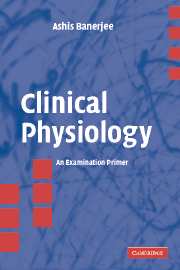10 - Endocrine Physiology
Published online by Cambridge University Press: 05 June 2016
Summary
Introduction
Endocrinology deals with the study of chemical messengers that travel via the blood and/or extracellular fluid and regulate tissue function, metabolism, growth, sexual development and reproduction.
General concepts
Regulatory systems
The components of endocrine regulatory systems are:
• A detector of homeostatic imbalance, usually manifested in altered circulating hormone levels or in alterations in the levels of blood constituents.
• A coupling mechanism to activate the secretory apparatus, usually involving feedback loops.
• The secretory apparatus.
• The hormone.
• An end organ capable of responding to the hormone. The target cells contain specific functional receptors with high specificity and affinity for the hormone. Hormone binding to the receptor causes the formation of an intracellular messenger molecule, which either stimulates or inhibits some characteristic biochemical activity of the target tissue. The coordinated tissue response to hormones involves the regulation, amplification and integration of signalling mechanisms at several levels.
• A detector to recognise that the hormonal effect has occurred.
• A mechanism for removing hormone from target cells and blood.
• A synthetic apparatus to replenish hormone in the secretory cells.
Hormone characteristics
The characteristics of a hormone are:
• It is produced by an endocrine or ductless gland, as opposed to an exocrine gland, which releases its products down a tube or duct.
• It acts as a chemical messenger, being secreted by cells into the blood or extracellular fluid, to act on target cells, which possess functional hormone receptors. The receptor consists of a specific binding site, a transduction element and an effector system. Hormones may inhibit, stimulate or regulate the functional activity of target organs or tissues.
• It may act locally, diffusing to adjacent cells (paracrine action).
• It may be carried by the bloodstream to act on distant target cells (endocrine action).
• It may act on the cell that produced it (autocrine action).
• Hormones produce their target cell actions either by enzyme activation or by modulation of gene expression.
Response to hormone
The magnitude of the response to a hormone is determined by:
The concentration of the hormone at the surface of the target cell, which in turn depends on the rate of production (under the control of positive and negative feedback loops); the rate of delivery (dependent on blood flow); and the rate of metabolism, degradation and elimination.
- Type
- Chapter
- Information
- Clinical PhysiologyAn Examination Primer, pp. 258 - 315Publisher: Cambridge University PressPrint publication year: 2005



